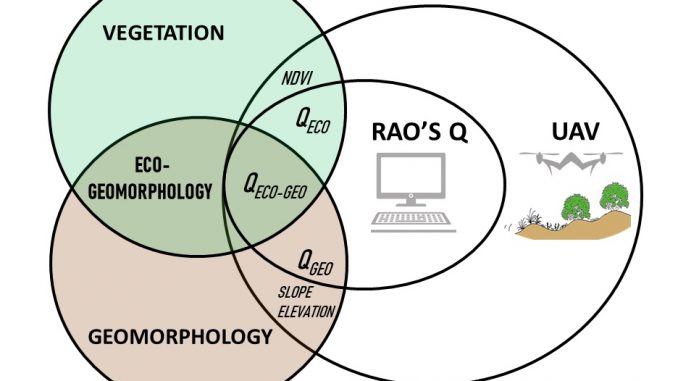
Question: Does spectral diversity captured by unmanned aerial systems (UAS) provide reliable information for monitoring the eco-geomorphological integrity of
Mediterranean coastal dune ecosystems? Can this information discriminate between two coastal areas with low (LP) and high (HP) human pressure?
Location: Tyrrhenian coast, Central Italy.
Methods: By processing UAS images, we derived the normalized difference vegetation index (NDVI) and topographic variables at high spatial resolution (0.5 m) for
150 m wide strips starting from the coastline inland on two representative coastal tracts under low and high human pressure. We mapped the sea–inland heterogeneity applying Rao’s Q index to the plant biomass (NDVI) and geomorphology variables (elevation and slope). Since Rao’s Q index can be calculated in a multidimensional space, we summarized the variability of these three variables into a single ecogeomorphological layer. We then inspected and compared how the Rao’s Q index values for plant biomass, geomorphology and eco-geomorphology change as a function of the distance from the sea between the two coastal sites.
Results: Rao’s Q heterogeneity values vary along the sea–inland gradient of well-preserved sites (LP). The maximum eco-geomorphological heterogeneity was found
at intermediate distances from the sea and decreased toward the inner sector where the dune geomorphology was more stable and vegetation more homogeneously distributed. Instead, Rao’s Q heterogeneity values featured constant low values along the gradient on the HP site, highlighting a simplified eco-geomorphological gradient related to the high human pressure.
Conclusions: Using UAS, the eco-geomorphological gradient of coastal dunes can be quantified at a very fine spatial resolution over management-relevant extents.
Rao’s Q index applied to sensing imagery successfully captured the differences in the eco-geomorphological heterogeneity along the sea–inland dune gradient and among sites with different levels of anthropic pressure. This approach supports frequent surveys and is particularly suitable for spatial monitoring of key coastal functions and services.
https://vegsciblog.org/2021/03/17/uas-based-monitoring-of-coastal-dunes/

Commenta per primo